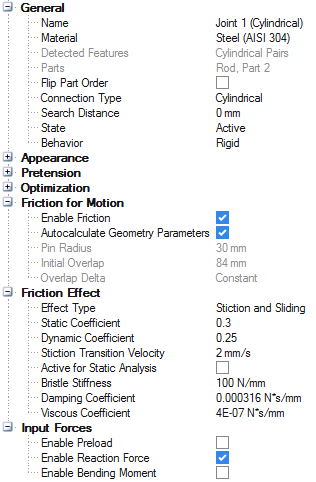Joint Friction
Forces that arise from frictional effects can be included in motion analysis for rigid joints using the Property Editor.
You can specify the coefficients of friction (static and dynamic) and include other model parameters which allow you to model frictional drag and stiction effects.
Joint fiction can only be enabled for rigid joints with one of the following joint types: Pin, Sliding Pin, Hinge, Cylindrical, Ball and Socket, and Translational.
- Select a joint and press F3 to open the Property Editor.
- Set the joint Behavior to Rigid.
- Select Enable Friction.
- For the Effect Type, select whether to include both Stiction and Sliding, or just one or the other.
- Select whether to make the friction effect Active for Static Analysis.
- Select which Input Forces to include.
Joint Friction Properties
Joint friction properties can be changed in the Property Editor, but require knowledge of frictional effects to be used appropriately.
Altair Inspire Motion uses the LuGre (Lundt-Grenoble) model for friction. Related properties are listed under Friction for Motion, Friction Effect, and Input Forces.

Figure 1. Property Editor for Joint Friction
Friction for Motion
- Enable Friction
- Select to enable the other friction-related options in the Property Editor. The Enable Friction option itself is only visible when the joint Behavior option is set to Rigid.
- Autocalculate Geometry Parameters
- This option is enabled by default. Disable it if you want to manually enter dimensions for geometry parameters such as the pin radius, friction arm, and bending arm.
Friction Effect
- Effect Type
- Specifies the frictional effect. By default, both static and dynamic friction are considered. The Stiction Only option uses only static friction, while the Sliding Only option uses only dynamic friction.
- Static Coefficient
- Specify the static friction coefficient (µs) in the joint.
- Dynamic Coefficient
- Specify the dynamic friction coefficient (µd) in the joint.
- Stiction Transition Velocity
- Specify the joint velocity at which the friction effect transitions from dynamic friction to static friction.
- Active for Static Analysis
- Disabled by default. Select this option to apply friction effects when running a static motion analysis.
Input Forces
Specifies the input forces for the friction model. The options available change based on the joint type, and include Preload, Reaction Force, Bending Moment, and Torsional Moment.